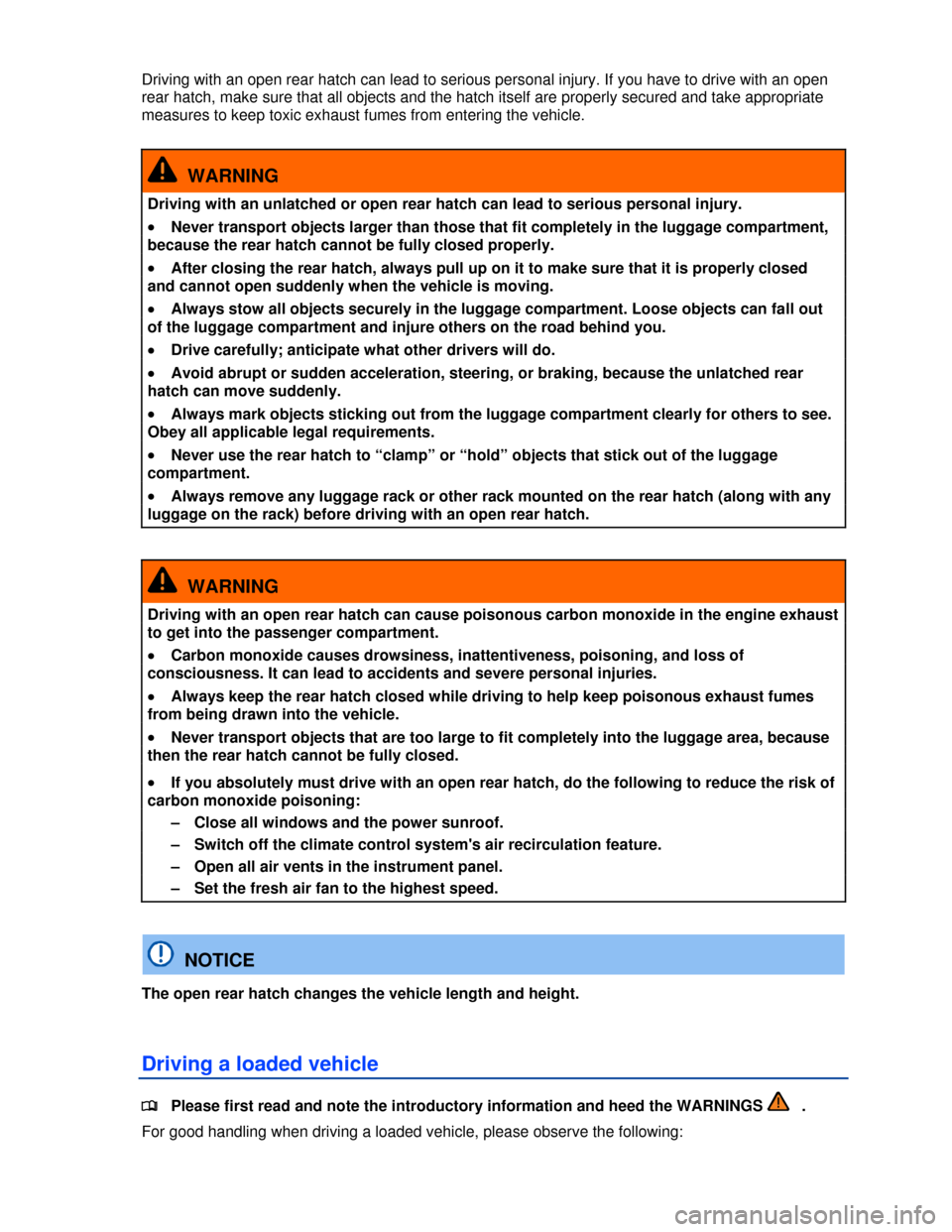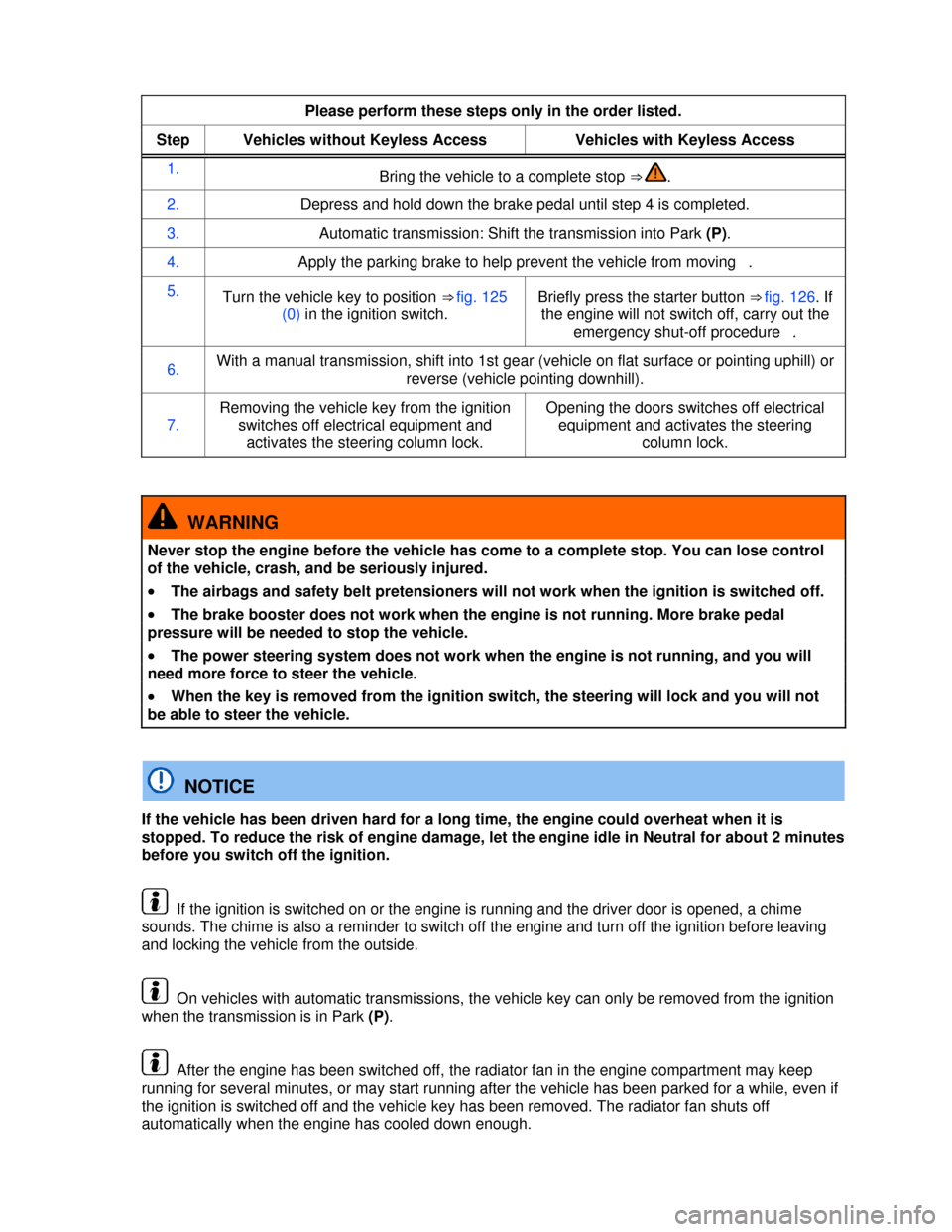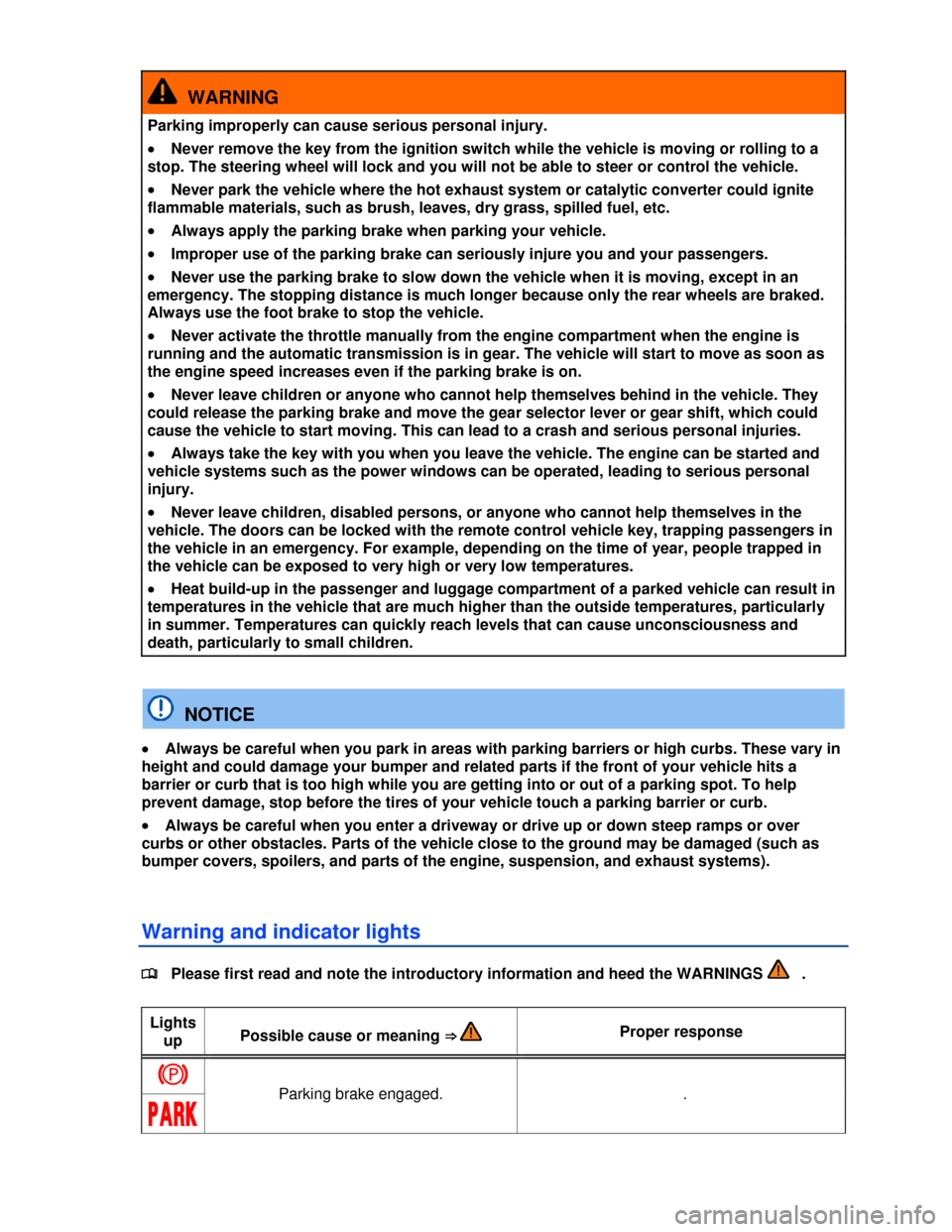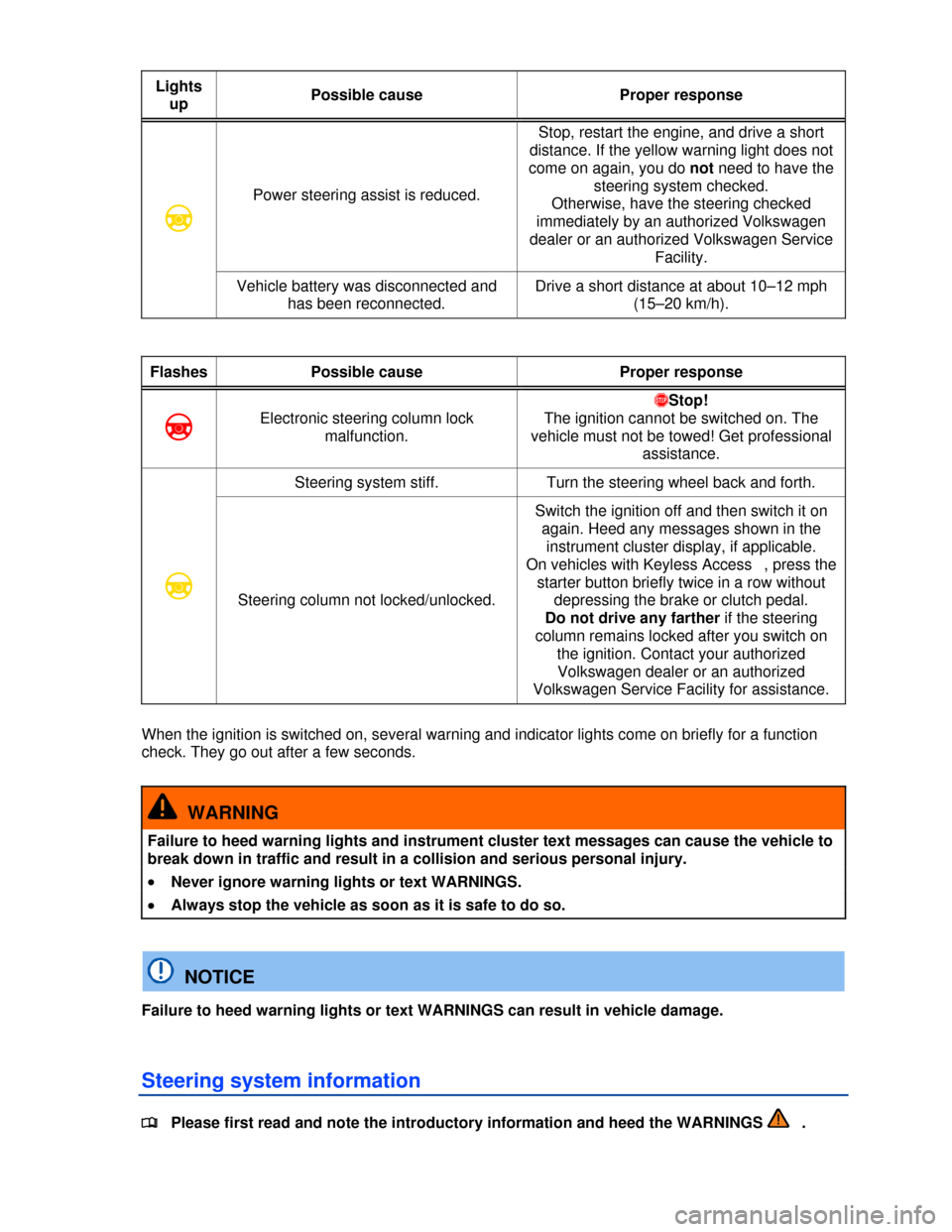2013 VOLKSWAGEN JETTA SPORTWAGEN power steering
[x] Cancel search: power steeringPage 46 of 324

Convenience features
To use the convenience closing feature to close all power windows and the sunroof, hold your finger
on the lock sensor surface on the outside of the door handle for a few seconds until the windows and
sunroof close.
Remove your finger from the lock sensor surface ⇒ fig. 27 (B) to stop the function. If you touch the
unlock sensor surface (A) on the inside of the door handle immediately after releasing the lock sensor
surface (B) (arrow), all of the windows will open (safety function).
Pinch protection is active during convenience closing of the windows and the power sunroof.
The settings in the Settings – Convenience menu determine which doors open when the door
handle unlocking surface is grasped.
NOTICE
The door handle sensor surfaces can be activated by a strong stream of water or steam if a
valid vehicle key is within range of the vehicle.
�x All windows may open if you turn the spray of water or steam away from and then back onto
the door handle sensor surface in quick succession. If at least one power window is opened
and the sensor is continuously activated, convenience closing is started.
The door may not open if the outside and inside door handles are used at the same time.
If the vehicle battery or the battery in the remote control vehicle key is weak or dead, it might not
be possible to unlock and lock the vehicle using Keyless Access. The vehicle can still be manually
locked or unlocked with the key bit .
The driver message Key not in range appears in the instrument cluster display if there is no
remote control vehicle key inside the vehicle or if the system does not recognize the remote control
vehicle key. The key may not be recognized, for example, if it is covered by something that interferes
with the signal (such as a briefcase), or if the remote control vehicle key battery is weak. Electronic
devices such as cell phones can also interfere with the signal.
Dirt on the door handles that contains a lot of salt (especially in winter) can affect the way the
door handle sensors work. Cleaning the door handles can help with this problem .
If the automatic transmission is not in Park (P) position, the electronic steering column lock will
not lock and the vehicle will not lock via sensors in the front door handles or the remote control vehicle
key.
Anti-theft alarm system
�
Page 47 of 324

The anti-theft alarm system is automatically activated when the vehicle is locked by pressing the lock
button on the remote control vehicle key.
When is the alarm triggered?
The anti-theft alarm system sounds for about 30 seconds and the turn signals flash for up to 5 minutes
if the following occurs with respect to the locked vehicle:
�x Opening a door that has been mechanically unlocked.
�x Forcibly opening a door.
�x Forcibly opening the engine hood.
�x Forcibly opening the rear hatch.
�x Switching on the ignition with an invalid key.
�x Disconnecting the vehicle battery.
Deactivating the alarm
Unlock the vehicle with the unlock button on the remote control vehicle key or switch on the ignition
with a valid vehicle key.
For vehicles with Keyless Access, the alarm can be deactivated by grasping one of the front door
handles when a valid vehicle key is in range or by holding the remote control vehicle key to the right of
the steering column trim and pressing the starter button
After the alarm has stopped and the vehicle is opened again in the same or a different area that
is protected by the alarm, the alarm is triggered again. For example, the alarm will sound again if the
rear hatch is opened after one of the doors has been opened.
The anti-theft alarm system is not activated when the vehicle is locked with the power lock
switch W on the inside of the driver or front passenger doors.
If the driver door is mechanically unlocked using the vehicle key bit, only the driver door is un-
locked, not the entire vehicle. Switching on the ignition deactivates the anti-theft alarm system and
activates the central locking button. To unlock the doors, use the central locking button or remote
control vehicle key.
If the vehicle battery is dead or weak, the anti-theft alarm system will not work properly.
Page 116 of 324

Driving with an open rear hatch can lead to serious personal injury. If you have to drive with an open
rear hatch, make sure that all objects and the hatch itself are properly secured and take appropriate
measures to keep toxic exhaust fumes from entering the vehicle.
WARNING
Driving with an unlatched or open rear hatch can lead to serious personal injury.
�x Never transport objects larger than those that fit completely in the luggage compartment,
because the rear hatch cannot be fully closed properly.
�x After closing the rear hatch, always pull up on it to make sure that it is properly closed
and cannot open suddenly when the vehicle is moving.
�x Always stow all objects securely in the luggage compartment. Loose objects can fall out
of the luggage compartment and injure others on the road behind you.
�x Drive carefully; anticipate what other drivers will do.
�x Avoid abrupt or sudden acceleration, steering, or braking, because the unlatched rear
hatch can move suddenly.
�x Always mark objects sticking out from the luggage compartment clearly for others to see.
Obey all applicable legal requirements.
�x Never use the rear hatch to “clamp” or “hold” objects that stick out of the luggage
compartment.
�x Always remove any luggage rack or other rack mounted on the rear hatch (along with any
luggage on the rack) before driving with an open rear hatch.
WARNING
Driving with an open rear hatch can cause poisonous carbon monoxide in the engine exhaust
to get into the passenger compartment.
�x Carbon monoxide causes drowsiness, inattentiveness, poisoning, and loss of
consciousness. It can lead to accidents and severe personal injuries.
�x Always keep the rear hatch closed while driving to help keep poisonous exhaust fumes
from being drawn into the vehicle.
�x Never transport objects that are too large to fit completely into the luggage area, because
then the rear hatch cannot be fully closed.
�x If you absolutely must drive with an open rear hatch, do the following to reduce the risk of
carbon monoxide poisoning:
– Close all windows and the power sunroof.
– Switch off the climate control system's air recirculation feature.
– Open all air vents in the instrument panel.
– Set the fresh air fan to the highest speed.
NOTICE
The open rear hatch changes the vehicle length and height.
Driving a loaded vehicle
�
Page 161 of 324

WARNING
Improper use of vehicle keys can result in serious personal injury.
�x Always take the key with you when you leave the vehicle. The engine can be started and
vehicle systems such as the power windows can be operated, leading to serious personal
injury.
�x Never leave children, disabled persons, or anyone who cannot help themselves in the
vehicle. The doors can be locked with the remote control vehicle key. This could result in
people being trapped in the vehicle in an emergency. For example, depending on the time of
year, people trapped in the vehicle can be exposed to very high or very low temperatures.
�x Heat build-up in the passenger and luggage compartment of a parked vehicle can result in
temperatures in the vehicle that are much higher than the outside temperatures, particularly
in summer. Temperatures can quickly reach levels that can cause unconsciousness and
death, particularly to small children.
�x Never remove the key from the ignition switch while the vehicle is moving or rolling to a
stop. The steering wheel will lock and you will not be able to steer or control the vehicle.
Leaving the key in the ignition for a long time when the engine is not running will drain the vehicle
battery.
Leaving the selector lever for a long period of time in any position other than Park (P) when the
ignition is switched off can drain the vehicle battery.
On automatic transmission vehicles, the vehicle key can be removed from the ignition switch
only when the transmission is in Park (P). You may have to press the release button on the
transmission selector lever to put the lever into Park (P).
Starter button
Fig. 126 Keyless Access locking and starting system: Starter button.
Page 165 of 324

Please perform these steps only in the order listed.
Step Vehicles without Keyless AccessVehicles with Keyless Access
1. Bring the vehicle to a complete stop ⇒ .
2. Depress and hold down the brake pedal until step 4 is completed.
3. Automatic transmission: Shift the transmission into Park (P).
4. Apply the parking brake to help prevent the vehicle from moving .
5. Turn the vehicle key to position ⇒ fig. 125
(0) in the ignition switch.
Briefly press the starter button ⇒ fig. 126. If
the engine will not switch off, carry out the
emergency shut-off procedure .
6. With a manual transmission, shift into 1st gear (vehicle on flat surface or pointing uphill) or
reverse (vehicle pointing downhill).
7.
Removing the vehicle key from the ignition
switches off electrical equipment and
activates the steering column lock.
Opening the doors switches off electrical
equipment and activates the steering
column lock.
WARNING
Never stop the engine before the vehicle has come to a complete stop. You can lose control
of the vehicle, crash, and be seriously injured.
�x The airbags and safety belt pretensioners will not work when the ignition is switched off.
�x The brake booster does not work when the engine is not running. More brake pedal
pressure will be needed to stop the vehicle.
�x The power steering system does not work when the engine is not running, and you will
need more force to steer the vehicle.
�x When the key is removed from the ignition switch, the steering will lock and you will not
be able to steer the vehicle.
NOTICE
If the vehicle has been driven hard for a long time, the engine could overheat when it is
stopped. To reduce the risk of engine damage, let the engine idle in Neutral for about 2 minutes
before you switch off the ignition.
If the ignition is switched on or the engine is running and the driver door is opened, a chime
sounds. The chime is also a reminder to switch off the engine and turn off the ignition before leaving
and locking the vehicle from the outside.
On vehicles with automatic transmissions, the vehicle key can only be removed from the ignition
when the transmission is in Park (P).
After the engine has been switched off, the radiator fan in the engine compartment may keep
running for several minutes, or may start running after the vehicle has been parked for a while, even if
the ignition is switched off and the vehicle key has been removed. The radiator fan shuts off
automatically when the engine has cooled down enough.
Page 180 of 324

WARNING
Parking improperly can cause serious personal injury.
�x Never remove the key from the ignition switch while the vehicle is moving or rolling to a
stop. The steering wheel will lock and you will not be able to steer or control the vehicle.
�x Never park the vehicle where the hot exhaust system or catalytic converter could ignite
flammable materials, such as brush, leaves, dry grass, spilled fuel, etc.
�x Always apply the parking brake when parking your vehicle.
�x Improper use of the parking brake can seriously injure you and your passengers.
�x Never use the parking brake to slow down the vehicle when it is moving, except in an
emergency. The stopping distance is much longer because only the rear wheels are braked.
Always use the foot brake to stop the vehicle.
�x Never activate the throttle manually from the engine compartment when the engine is
running and the automatic transmission is in gear. The vehicle will start to move as soon as
the engine speed increases even if the parking brake is on.
�x Never leave children or anyone who cannot help themselves behind in the vehicle. They
could release the parking brake and move the gear selector lever or gear shift, which could
cause the vehicle to start moving. This can lead to a crash and serious personal injuries.
�x Always take the key with you when you leave the vehicle. The engine can be started and
vehicle systems such as the power windows can be operated, leading to serious personal
injury.
�x Never leave children, disabled persons, or anyone who cannot help themselves in the
vehicle. The doors can be locked with the remote control vehicle key, trapping passengers in
the vehicle in an emergency. For example, depending on the time of year, people trapped in
the vehicle can be exposed to very high or very low temperatures.
�x Heat build-up in the passenger and luggage compartment of a parked vehicle can result in
temperatures in the vehicle that are much higher than the outside temperatures, particularly
in summer. Temperatures can quickly reach levels that can cause unconsciousness and
death, particularly to small children.
NOTICE
�x Always be careful when you park in areas with parking barriers or high curbs. These vary in
height and could damage your bumper and related parts if the front of your vehicle hits a
barrier or curb that is too high while you are getting into or out of a parking spot. To help
prevent damage, stop before the tires of your vehicle touch a parking barrier or curb.
�x Always be careful when you enter a driveway or drive up or down steep ramps or over
curbs or other obstacles. Parts of the vehicle close to the ground may be damaged (such as
bumper covers, spoilers, and parts of the engine, suspension, and exhaust systems).
Warning and indicator lights
�
Page 187 of 324

slush or snow, ESC cannot perform the same way it would on a dry surface. If the vehicle
“hydroplanes” (rides on a cushion of water instead of the road surface), ESC will not be able to help
you steer the vehicle because contact with the pavement has been interrupted and the vehicle cannot
be braked or steered. During fast cornering, particularly on winding roads, ESC cannot always deal as
effectively with difficult driving situations as it can at lower speeds. When towing a trailer, ESC is not
able to help you regain control as it would if you were not towing a trailer.
Always adjust your speed and driving style to visibility, road, traffic, and weather conditions. ESC
cannot override the vehicle's physical limits, increase the available traction, or keep a vehicle on the
road if road departure is a result of driver inattention. Instead, ESC improves the possibility of keeping
the vehicle under control and on the road during extreme maneuvers by using the driver's steering
inputs to help keep the vehicle going in the intended direction. If you are traveling at a speed that
causes you to run off the road before ESC can provide any assistance, you may not experience the
benefits of ESC.
ESC includes and/or works together with the ABS, BAS, ASR, EDL, and XDL systems (see below).
ESC is switched on all the time. In certain situations when you need less traction or additional traction
cannot be achieved, you can switch off ASR by pressing the �mbutton ⇒ fig. 137. Be sure to switch ASR
on again when you no longer need less traction.
Anti-Lock Brake System (ABS)
ABS helps to keep the wheels from locking up and helps to maintain the driver's ability to steer and
control the vehicle. This means the vehicle is less likely to skid, even during hard braking:
�x Push the brake pedal down hard and hold it there. Don't take your foot off the pedal or reduce the
force on the pedal!
�x Do not “pump” the brake pedal or let up on it!
�x Steer the vehicle while pushing down hard on the brake pedal.
�x ABS stops working if you release or let up on the brake.
When ABS is doing its job, you will notice a slight vibration through the brake pedal and hear a
noise. ABS cannot shorten the stopping distance under all conditions. The stopping distance may
even be longer, for instance, when driving on gravel or on newly fallen snow covering an icy or
slippery surface.
Brake Assist (BAS)
The Brake Assist System can help to reduce stopping distances. If you press the brake pedal very
quickly, BAS detects an emergency situation. It then very quickly builds up full brake system pressure,
maximizing braking power and reducing the stopping distance. This way, ABS can be activated more
quickly and efficiently.
Do not reduce pressure on the brake pedal! BAS switches off automatically as soon as you release or
let up on the brake.
Anti-Slip Regulation (ASR)
ASR reduces engine power directed to spinning wheels and adjusts power to the road conditions.
Even under poor road conditions, ASR can make it easier to get moving, accelerate, and climb hills.
ASR can be switched on or off manually .
Electronic Differential Lock (EDL and XDL)
EDL is applied during regular straight-line acceleration. EDL gently brakes a drive wheel that has lost
traction (spinning) and redirects the drive force to other drive wheels. In extreme cases, EDL
automatically switches off to keep the brake from overheating. As soon as the brake has cooled down,
EDL automatically switches on again.
XDL is an extension of the Electronic Differential Lock system. XDL does not react to drive wheel
slippage when driving straight ahead. Instead, XDL detects slippage of the inside front wheel during
fast cornering. XDL applies enough brake pressure to this wheel in order to stop the slippage. This
improves traction, which helps the vehicle stay on track.
Page 197 of 324

Lights
up Possible cause Proper response
�D
Power steering assist is reduced.
Stop, restart the engine, and drive a short
distance. If the yellow warning light does not
come on again, you do not need to have the
steering system checked.
Otherwise, have the steering checked
immediately by an authorized Volkswagen
dealer or an authorized Volkswagen Service
Facility.
Vehicle battery was disconnected and
has been reconnected.
Drive a short distance at about 10–12 mph
(15–20 km/h).
Flashes Possible cause Proper response
�D Electronic steering column lock
malfunction.
�